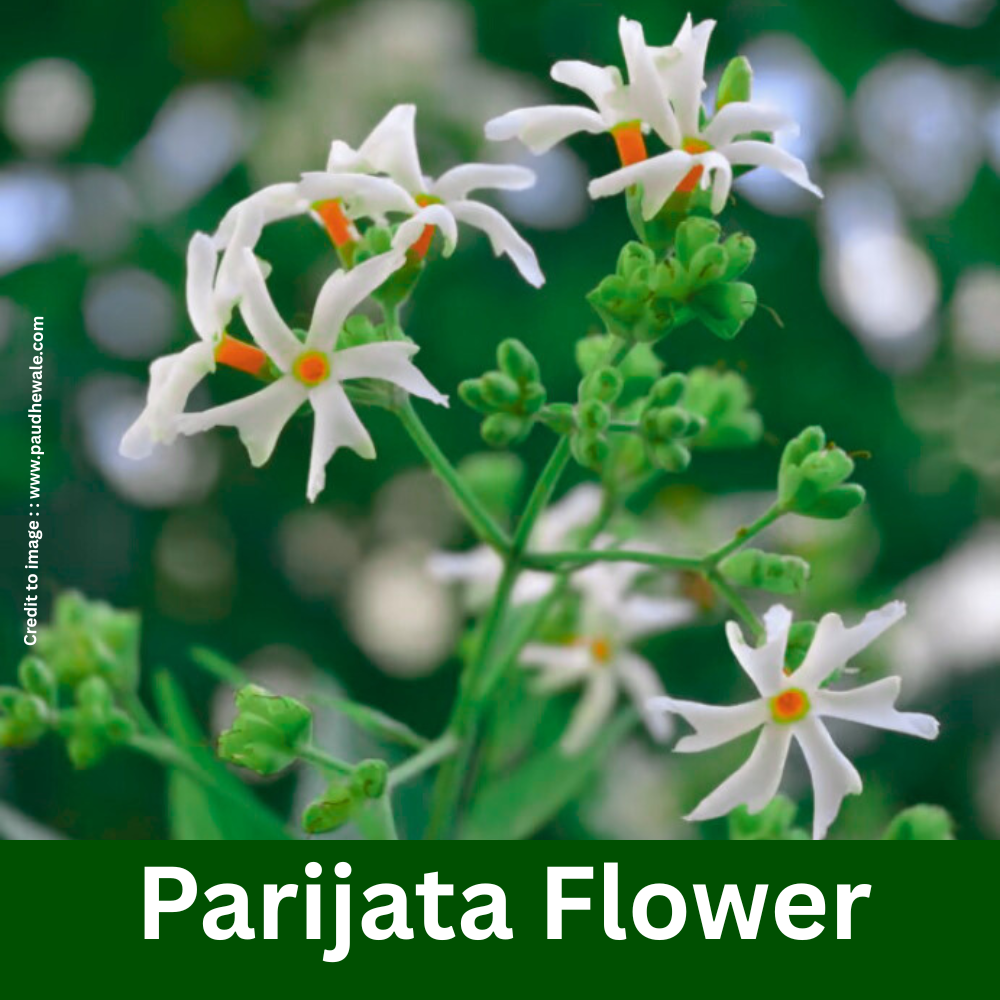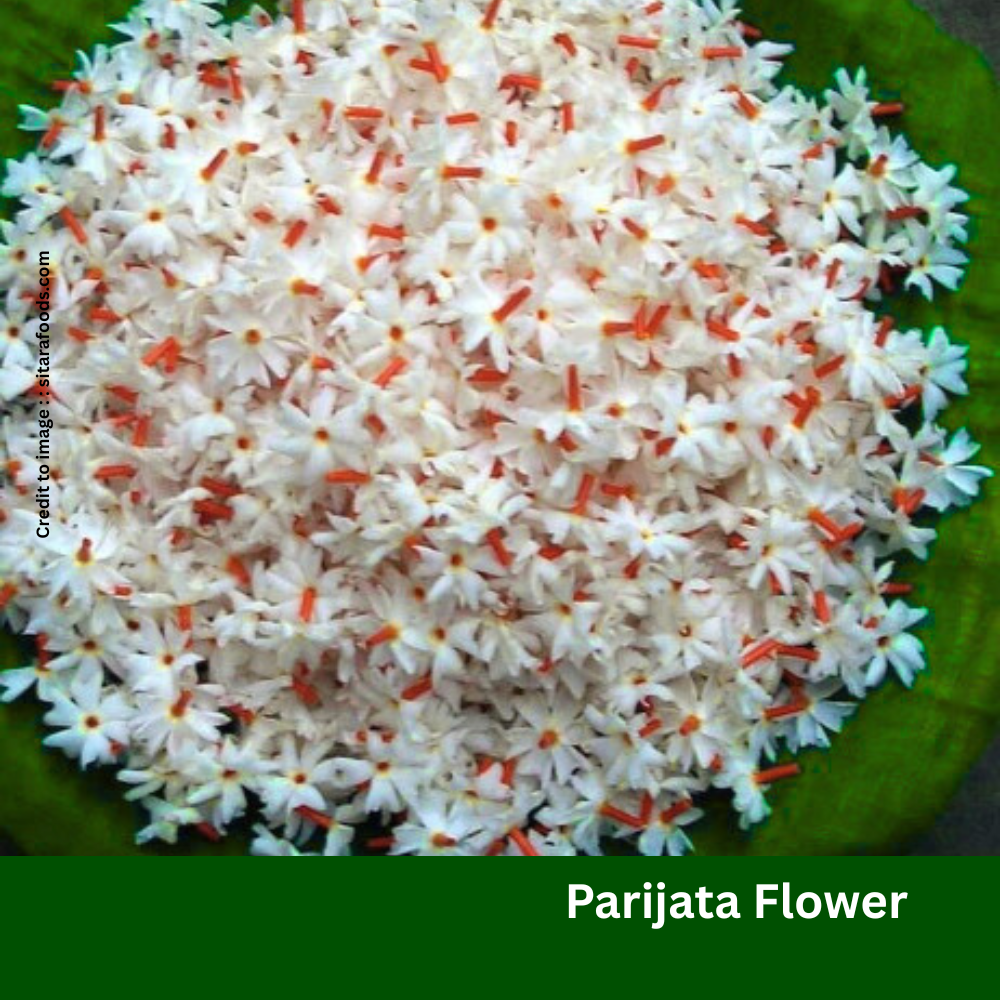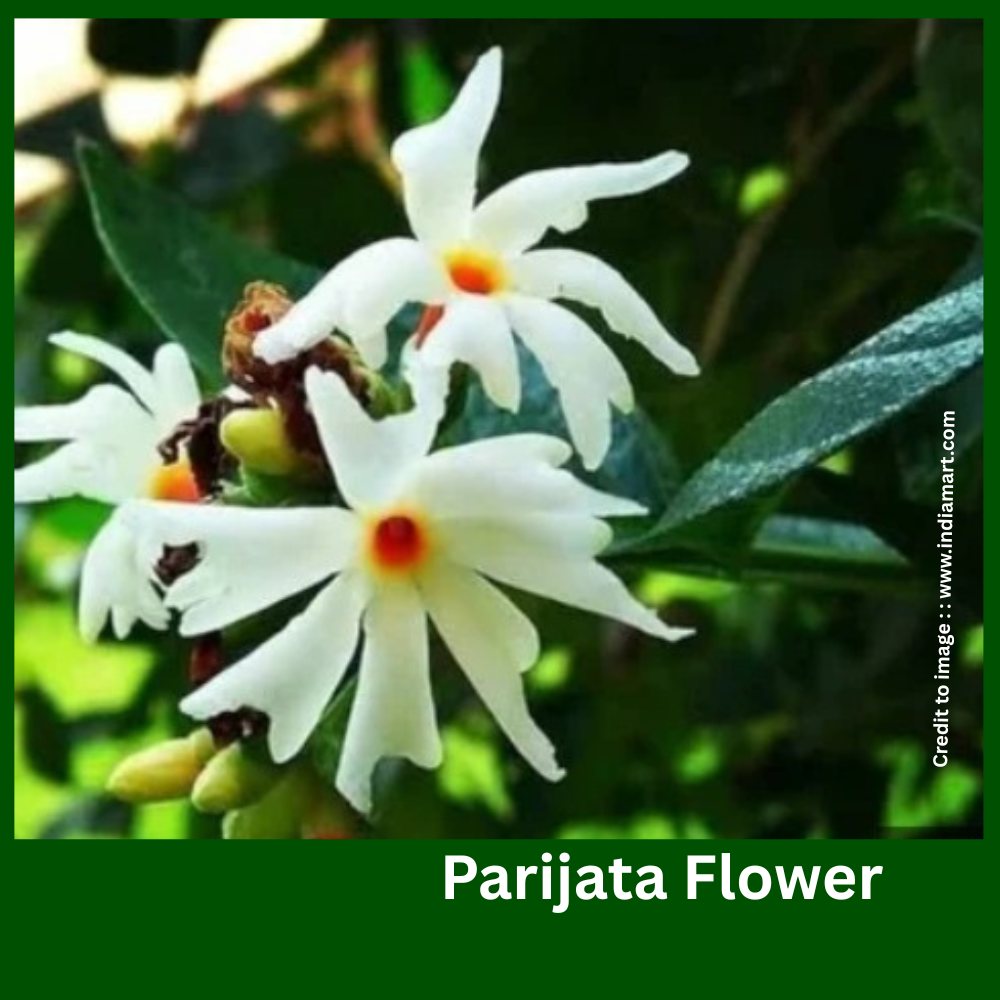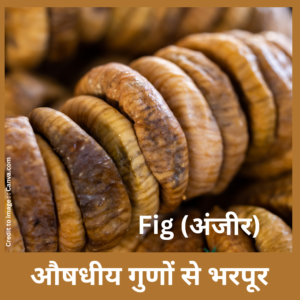The Parijata Flower also known as Nyctanthes arbor-tristis. It is a divine blossom with roots embedded in Hindu mythology and medicinal botany. Revered for its celestial origin and therapeutic properties, the Parijata Flower blooms at night and sheds its fragrant petals by dawn. Article “Parijata Flower Insights” explores its mythological essence, geographical distribution, botanical features, scientific data, and global cultural presence. Fulfills with spiritual and scientific relevance of this sacred flower.
Parijata Flower Insights :
The Parijata Flower is more than just a beautiful blossom—it is a symbol of divine love, sacrifice, and eternal beauty. Popularly known in India as “Harsingar” or “Night-Flowering Jasmine,” this flower plays a significant role in Hindu rituals and Ayurveda. Identified scientifically as Nyctanthes arbor-tristis. This fragrant blossom in the night sky. And gracefully dropping its petals by dawn.
Botanical Information Table of Parijata Flower
| Feature | Description |
| Botanical Name | Nyctanthes arbor-tristis |
| Common Names | Parijata, Harsingar, Night Jasmine |
| Family | Oleaceae |
| Plant Type | Small deciduous tree or shrub |
| Height | 10–12 feet |
| Flower Color | White petals with orange tube |
| Bloom Time | Night (petals fall by morning) |
| Lifespan | Perennial |
Scientific Data Table of Parijata Flower
| Scientific Aspect | Details |
| Phytochemical Components | Nyctanthin, Tannins, Flavonoids, Glycosides |
| Medicinal Uses | Anti-inflammatory, Antibacterial, Antiviral |
| Traditional Uses | Fever, Malaria, Skin diseases, Arthritis |
| Research Studies | Recognized in Ayurveda and modern pharmacology |
| Toxicity | Non-toxic (in recommended dosages) |
Geographical Distribution Table
| Region | Distribution Details |
| India | Widely found in Uttar Pradesh, Bihar, Assam |
| Nepal | Commonly grown in gardens and temples |
| Sri Lanka | Cultivated in religious sites |
| Southeast Asia | Native and naturalized regions |
| Subtropical Africa | Found in East African countries |
Country-Wise Presence of Parijata Flower
| Country | Status | Cultural Use |
| India | Native | Religious, Ayurvedic, Ornamental |
| Nepal | Cultivated | Temple offerings |
| Bangladesh | Naturalized | Medicinal |
| Sri Lanka | Native/Cultivated | Garden ornamental |
| Thailand | Cultivated | Decorative and spiritual use |
| Indonesia | Rare | Herbal traditions |
| Kenya | Introduced | Landscaping |
Medicinal and Ayurvedic Benefits
Leaves of flowers used for fever and joint pain .Used by boiling .
Flowers help in treating respiratory issues. And also used in herbal teas.
Seeds and Bark of Flowers are having anti-inflammatory and antifungal properties.
Parijata flowers is “Rasayana”. A rejuvenating herb in Ayurveda .
Environmental and Ecological Role
Attracts pollinators like moths and butterflies at night.
Acts as a natural air purifier with its aromatic release.
Its quick-shedding flowers enrich the soil as organic matter.
Religious and Mythological Significance of Parijata Flower
The Parijata Flower holds a sacred place in Hindu mythology. Originate during the Samudra Manthan (Churning of the Ocean) as per Hindu mythology . This flower planted in the celestial gardens of Indra, the king of gods. According to legends:
Lord Krishna brought the Parijata tree from heaven to Earth for his beloved consort, Queen Satyabhama, after a divine conflict with Lord Indra.
The flower symbolizes divine love and devotion, making it a key offering in temples, especially during Krishna Janmashtami and Navratri.
In some regions of India flower connected with Lord Shiva. Used in early morning rituals.
🌸 Parijata Flower Color Varieties Table
Parijata Flower is primarily known for its unique white petals and orange-red tube, there are regional color variations and aesthetic perceptions among cultivators and botanists.
| Part of Flower | Color Description | Notes |
| Petals | Pure White | Symbol of purity and serenity |
| Flower Tube/Base | Deep Orange to Saffron | Represents devotion and spiritual energy |
| Bud (Before Bloom) | Pale Green to Light Yellow | Often seen in early morning gardens |
| Dried Petals | Creamy White | Used in herbal tea and dry flower crafts |
🌿 How to Grow and Care for Parijata Flower Tree: Gardening Method
The Parijata Flower is ideal for spiritual gardens, temple premises, herbal landscapes, and even large pots on balconies. Here’s a step-by-step gardening guide:
🌱 Parijata Flower Gardening Method Table
| Step | Instructions |
| Soil Type | Well-drained, loamy soil with good organic content |
| Sunlight | Important : Partial shade to full sunlight (5 to 6 hrs Daily ) |
| Watering | Moderate; water when topsoil is dry. Avoid waterlogging |
| Planting Season | Spring or monsoon is ideal for transplantation |
| Propagation Method | Stem cutting or seed propagation |
| Fertilization | Use organic compost or cow dung every 45 days |
| Pruning | Light pruning : After flowering to maintain shape of Flowers |
| Pests/Diseases | Generally pest-free; use neem oil spray for occasional fungal infections |
| Container Planting | Use large earthen/ceramic pots with proper drainage |
🍵 How to Make Parijata Flower Herbal Tea: Healing in Every Sip
Parijata flowers used in Ayurvedic infusions and wellness teas for generations. The tea helps with respiratory health, joint pain, fever, and overall relaxation.
🌼 Parijata Flower Tea-Making Procedure (Parijata Flower Insights)
| Step | Instruction |
| Ingredients | 4–5 fresh Parijata flowers (or 1 tbsp dried petals), 1.5 cups water, honey (optional) |
| Cleaning | Rinse the flowers gently in fresh water to remove dust |
| Boiling | Boil 1.5 cups of water, then add flowers and simmer for 5–7 minutes |
| Straining | Strain the tea into a cup using a fine mesh |
| Add Sweetener | Add honey or jaggery (if desired), avoid milk |
| Serve | Drink warm, preferably on an empty stomach or in the evening |
📝 Tip: Dried petals can be stored in an airtight glass jar for up to 3 months and used similarly.
✅ Medicinal Benefits of Parijata Tea
Reduces joint inflammation and pain (anti-arthritic)
Helps ease sore throat and cough
Supports healthy sleep due to mild sedative properties
Detoxifies the body with antioxidant-rich infusion
FAQs about Parijata Flower Insights -A
- What is the Parijata Flower?
The Parijata Flower is a night-blooming plant known for its sacred significance and medicinal uses. - What is its scientific name?
Nyctanthes arbor-tristis. - Why is it called the Night Jasmine?
Because it blooms at night and drops its flowers at dawn. - What is the myth behind the Parijata tree?
It originated from the Samudra Manthan and was brought to Earth by Lord Krishna. - Is the Parijata tree found only in India?
While native to India, it is also found in Nepal, Sri Lanka, and Southeast Asia. - Can Parijata flowers be used in Ayurvedic medicine?
Yes, it is used to treat fevers, cough, joint pain, and skin conditions. - What does ‘arbor-tristis’ mean?
It means “sad tree,” because it loses its flowers every morning. - Is the Parijata tree evergreen?
No, it is deciduous and sheds leaves in some seasons. - Can we grow Parijata at home?
Yes, it grows well in warm climates with well-drained soil. - Does the Parijata flower attract insects?
Yes, mainly moths and butterflies.
FAQs about Parijata Flower Insights-B
- What is the spiritual meaning of the Parijata flower?
It symbolizes love, purity, and divine connection. - How tall does the Parijata tree grow?
It typically grows up to 10–12 feet tall. - Are the flowers used in temple rituals?
Yes, especially in offering to Krishna and Shiva. - Is the flower used in perfumes?
Yes, due to its unique night fragrance. - Does the plant require much maintenance?
No, it is a hardy plant requiring moderate care.
Conclusion
The Parijata Flower is a symbol of heavenly beauty, rich cultural heritage, and profound healing power. From its origins in Hindu legends to its utility in modern Ayurveda, it continues to inspire spiritual and scientific inquiry. As global interest in natural remedies and sacred plants grows, the Parijata Flower stands out as a beacon of timeless relevance and beauty.
References
- Sharma, R. (2015). Ayurveda and Medicinal Plants. New Delhi: AyurWorld Press.
- Singh, N. & Tiwari, A. (2021). “Phytochemical and Pharmacological Properties of Nyctanthes arbor-tristis”. International Journal of Herbal Medicine.
- Ministry of AYUSH, Government of India. (2020). Medicinal Plants Database.
- Bhagavata Purana & Vishnu Purana – Mythological Texts on Krishna and Parijata.
- Botanical Survey of India Reports, 2022.
PRAKRITI DARSHAN-NATURE AND ENVIRONMENT MAGAZINE
Prakriti Darshan is a leading Hindi-language magazine and digital platform dedicated to raising public awareness on vital issues related to nature, biodiversity, climate change, sustainable development, and environmental conservation. This magazine represents a unique blend of science, society, and sensitivity—offering a common platform for researchers, students, NGOs, policymakers, nature lovers, and conscious citizens alike.
With thought-provoking articles, inspiring stories, environmental research, impactful projects, and policy perspectives, Prakriti Darshan is a transformative journey toward a greener and more sustainable future.
Let us come together to protect and preserve our planet for generations to come. 🌿🌍
Join us in our mission to protect and celebrate the planet. 🌏💚
Click for more information
- Visit www.prakritidarshan.com for Free Magazine ,Free membership benefits ,offered price magazine @ Rs.1 or Rs.11 only and more ……
- 🎗️Sponsor Prakriti Darshan Magazine – Support our environment mission.
- 📚 Explore the Environment Magazine – Read our latest and past issues.
- ✍️ Read Editor’s Article or Blog – Insightful thoughts from our editorial desk.
- 🌱 Join Membership – Be part of India’s leading green community.
- 🤝 Become an NGO Impact Story Partner – Share your grassroots impact nationwide.
- 🏢 Become a Company Partner – Showcase your CSR, ESG, or sustainability work.
- 👤 Become an Individual Partner – Volunteer, write, and raise your green voice.
- 📢 Advertise with Us – Reach eco-conscious readers across India.
- Eco Trails Newsletter
- Donate for “Hari Ho Vashundhara & Har school Hariyali “ Plantation campaign Associated Partner NGO :GDSS NGO www.gdssngo.org
BALA DATT SHARMA,
MANAGING EDITOR ,
PRAKRITI DARSHAN-NATURE AND ENVIRONMENT MAGAZINE
- Yamuna River- Lifeline of North India :A Scientific, Agricultural, and Environmental Perspective - July 14, 2025
- Jurassic World Rebirth Breaks Box Office Records : Global Box Office Revenue $1.5 Billion (And rising) Globally with a Roaring Environmental Message - July 14, 2025
- African Elephant: Facts, Types, Scientific Data, and Why Their Survival Matters for Our Planet - July 13, 2025










